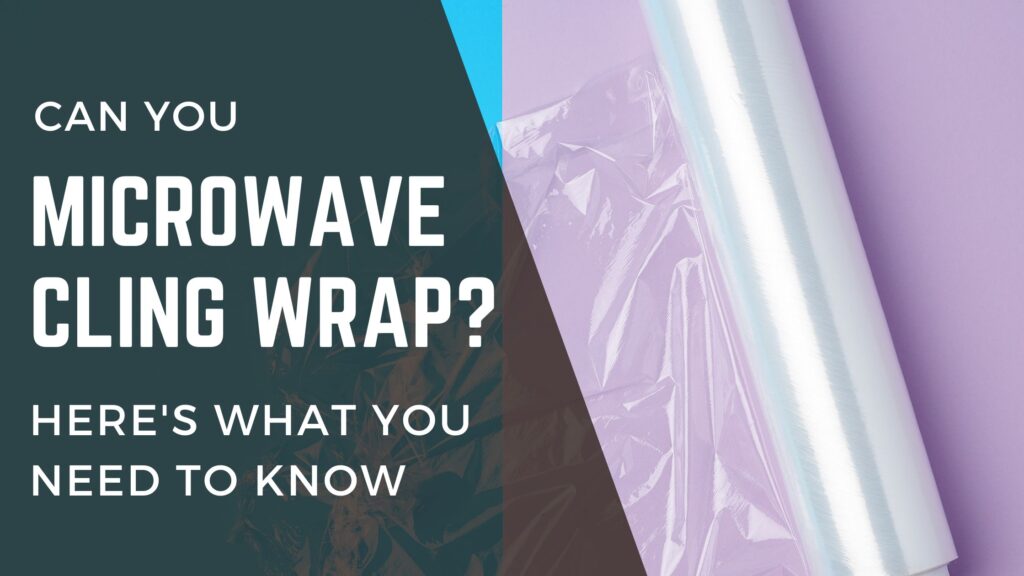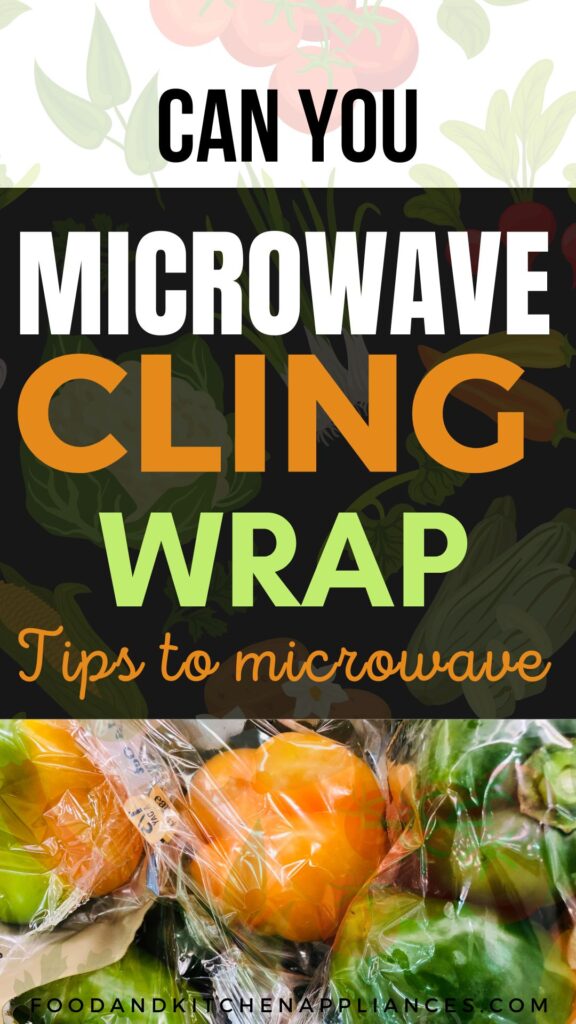Have you ever wondered whether it is safe to microwave cling wrap? While it may seem like a convenient way to reheat leftovers or cover your food, there are concerns about the potential health risks of microwaving cling wrap.
In this article, we will explore whether it is safe to microwave cling wrap and what precautions you can take to minimize any potential risks.
USDA states that it is fine to microwave the plastic until it is written that it is microwave safe. Also, the food should not come into direct contact with food. Cling wrap can release harmful chemicals that may contaminate your food when heated in the microwave. However, not all cling wrap is created equal, and some types are safer to use in the microwave than others.

Can you microwave cling wrap?
When it comes to microwaving cling wrap, there is a lot of conflicting information out there. Some people claim that it is safe to do so, while others warn against it. So, can you microwave cling wrap? The answer is: it depends.
Some types of cling wrap are specifically designed for use in the microwave, while others are not. If you are unsure whether your cling wrap is microwave-safe, check the packaging or contact the manufacturer for more information.
Assuming that your cling wrap is microwave-safe, it is still important to take precautions when using it in the microwave. Here are some tips to keep in mind:
- Do not let the cling wrap touch the food directly. Instead, leave a small gap between the food and the cling wrap to allow steam to escape.
- Use a microwave-safe dish to heat your food, and cover it with the cling wrap. This will help to prevent any splatters or spills.
- Only use cling wrap once. Reusing cling wrap can cause it to break down and release harmful chemicals.
Always check the packaging or contact the manufacturer to ensure that your cling wrap is microwave-safe, and take precautions when using it in the microwave to avoid any potential hazards.
Understanding Cling Wrap
Cling wrap, also known as plastic wrap or cling film, is a thin plastic material that is commonly used to cover food items. It is made of polyvinylidene chloride (PVDC) or low-density polyethylene (LDPE). Cling wrap is designed to stick to itself and form an airtight seal around the food, which helps to keep it fresh and prevent it from drying out.
To ensure that you are using cling wrap safely, always check the packaging to see if it is labeled as microwave-safe. If it is not, you should not use it in the microwave.
Instead, use a microwave-safe container or a microwave-safe lid to cover your food.
In addition to its use in the kitchen, cling wrap can also be used for various other purposes. For example, it can be used to wrap and protect items during transportation or storage.
It can also be used to cover and protect surfaces during painting or other messy projects.
Microwave Safety of Cling Wrap
While cling wrap is a convenient way to cover food, it is essential to use it correctly to avoid any potential hazards.
Firstly, you should always ensure that the cling wrap you use is microwave-safe. This means that it is specifically designed to withstand the heat generated by a microwave without melting or releasing harmful chemicals.
Most cling wraps that are labeled as microwave-safe will have instructions on the packaging regarding their use in the microwave.
Secondly, you should avoid using cling wrap to cover fatty or greasy foods, as these can cause the wrap to melt or warp.
This can ruin your food and release harmful chemicals into the air and onto your food.
Another essential safety tip is to ensure the cling wrap does not touch the food directly. This can cause the wrap to melt onto the food, which can be dangerous to consume.
To avoid this, you can place a layer of paper towel or a microwave-safe plate over the food before covering it with the cling wrap.
Potential Risks of Microwaving Cling Wrap
Chemical Leakage
When you microwave cling wrap, there is a risk of chemical leakage. Cling wrap is made of polyvinyl chloride (PVC) or low-density polyethylene (LDPE), which can release harmful chemicals when heated. These chemicals can contaminate your food and cause health problems.
Melting Risk
Cling wrap can melt when exposed to high temperatures, such as those in a microwave. It can stick to your food when it melts and cause a choking hazard.
Also, melted cling wrap can release harmful chemicals that contaminate your food.
Fire Hazard
If cling wrap is exposed to high temperatures, it can catch fire. This can happen if plastic touches the walls or ceiling of the microwave or if it comes into contact with a hot plate or food.
A fire caused by cling wrap can be dangerous and cause damage to your appliances or kitchen.
To avoid these potential risks, it is recommended that you do not use plastic wraps. Instead, use microwave-safe containers or cover your food with a microwave-safe lid or paper towel.
If you must use cling wrap, ensure it does not touch the food and use it for short periods at low temperatures.
Always follow the manufacturer’s instructions and never leave the microwave unattended while in use.
Alternatives to Cling Wrap in Microwave
Microwave-Safe Covers
You can use microwave-safe covers when you need to cover your food in the microwave. These covers are designed to withstand the microwave’s heat and prevent splatters.
They come in various sizes and shapes, so you can find one that fits your dish. Some microwave-safe covers are made of silicone, while others are made of tempered glass.
Silicone covers are flexible and easy to use. They can be washed and reused many times. They are also dishwasher safe. Tempered glass covers are more durable than silicone covers.
They are microwave and oven safe. They can be washed in the dishwasher but are prone to breaking if dropped.
Paper Towels
Another alternative to cling wrap is paper towels. Place a damp paper towel over your food to prevent splatters.
The paper towel will absorb excess moisture and prevent your food from drying. Please make sure the paper towel is damp, not wet, or it will stick to your food.
Paper towels are cheap and readily available. They are also biodegradable and better for the environment than cling wrap. However, they are not reusable, so you must use a new one each time you microwave your food.
Microwave-Safe Containers
If you want to avoid using disposable materials in the microwave, use microwave-safe containers.
These containers are made of materials that can withstand the microwave’s heat. They come in various sizes and shapes, so you can find one that fits your dish.
Microwave-safe containers are reusable and dishwasher-safe.
They are also better for the environment than cling wrap and paper towels.
However, they can be more expensive than disposable alternatives. Check the label to ensure the container is microwave safe before using it in the microwave.
Why some cling wraps are labeled microwave safe and some not?
When it comes to cling wrap, not all types are created equal. Some cling wraps are labeled as microwave-safe, while others are not. So, why is this the case?
The answer lies in the materials used to make the cling wrap. Microwave-safe cling wrap is made from materials that are designed to withstand the high temperatures and pressures that occur in a microwave.
These materials include polyethylene, which is a type of plastic, and other food-safe additives that help the cling wrap hold up under the heat.
On the other hand, regular cling wrap is made from PVC, or polyvinyl chloride, which is not microwave safe. PVC can release toxic chemicals when it is heated, which can be harmful to your health. That’s why it’s important to always check the label before using it in the microwave.
In addition to the materials used, the thickness of the cling wrap can also play a role in whether it is safe to use in the microwave. Thicker cling wrap is generally more durable and less likely to break or melt in the microwave, so some brands may label their thicker cling wrap as microwave-safe.
Is it OK to microwave food with plastic wrap?
When it comes to microwaving food with plastic wrap, there are a few things you should keep in mind. While it might be tempting to use cling wrap to cover your leftovers or microwaveable meals, there are some potential risks to consider.
First, it’s important to note that not all types of plastic wrap are microwave-safe. Some plastic wraps can melt or release harmful chemicals when exposed to high temperatures.
Always check the packaging or manufacturer’s instructions before using plastic wrap in the microwave.
If you use microwave-safe plastic wrap, leave a small vent or opening in the wrap to allow steam to escape. This can help prevent the plastic from melting or warping and can also help prevent steam burns.
Another thing to keep in mind is that plastic wrap can sometimes create a seal that traps steam and heat, causing the food to cook unevenly or even explode. To avoid this, prick some holes in the covering to help steam release from the container.
Or try using a microwave-safe lid or cover instead of plastic wrap.

Frequently Asked Questions
Is it safe to microwave cling wrap?
Yes, it is safe to microwave cling wrap as long as you use it properly. Ensure that the cling wrap does not touch the food directly and that you leave a vent for the steam to escape.
What happens if you microwave cling wrap?
If you microwave cling wrap for too long or if it touches the food directly, it can melt and release harmful chemicals. This can contaminate your food and potentially harm your health.
Can cling wrap melt in the microwave?
Yes, cling wrap can melt in the microwave if it is heated for too long or if it comes into direct contact with the food. It is essential to use microwave-safe cling wrap or to use a microwave-safe container with a lid to avoid any potential melting.
Is Reynolds Wrap microwave safe?
Yes, Reynolds Wrap is microwave safe. However, always follow the package’s instructions and do not use it in direct contact with the food.
Can you use Cling n Seal in the microwave?
Cling n Seal is not recommended for use in the microwave. You can use to microwave food if you provide a barrier between the food and the cling wrap and don’t use it with fatty and greasy foods.
How to Melt Caramel in Microwave? Quick and Easy Method
Can You Microwave Totino’s Pizza?
Can you Microwave Water Bottles? Here’s What You Need to Know